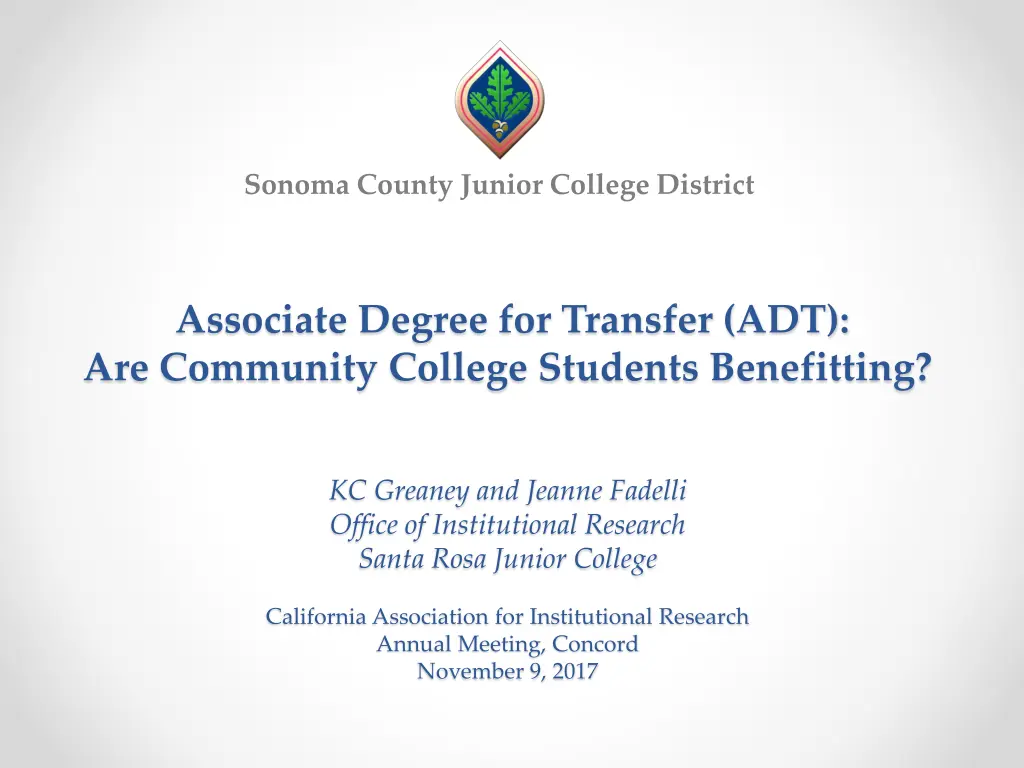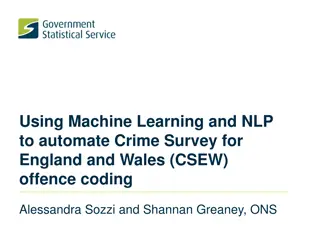
Sonoma County Junior College District ADT Impact Study
"Discover how Associate Degrees for Transfer (ADTs) at Santa Rosa Junior College benefit community college students in Sonoma County. Explore insights on ADT awards, time to degree, and student success factors for transfer to 4-year colleges and universities."
Download Presentation

Please find below an Image/Link to download the presentation.
The content on the website is provided AS IS for your information and personal use only. It may not be sold, licensed, or shared on other websites without obtaining consent from the author. If you encounter any issues during the download, it is possible that the publisher has removed the file from their server.
You are allowed to download the files provided on this website for personal or commercial use, subject to the condition that they are used lawfully. All files are the property of their respective owners.
The content on the website is provided AS IS for your information and personal use only. It may not be sold, licensed, or shared on other websites without obtaining consent from the author.
E N D
Presentation Transcript
Sonoma County Junior College District Associate Degree for Transfer (ADT): Are Community College Students Benefitting? KC Greaney and Jeanne Fadelli Office of Institutional Research Santa Rosa Junior College California Association for Institutional Research Annual Meeting, Concord November 9, 2017
ADTs: Established by SB1440 in 2010 The Student Transfer Achievement Reform Act : 1. Authorized California Community Colleges (CCCs) to confer transfer associate degrees of no more than 60 required lower division units (ADTs) 2. ADT transfer students given priority admission to a degree program which has been deemed similar at the California State University (CSU) 3. The CSU major must not require more than 60 units 4. Agreement nullified if student changes major or double majors at CSU
SRJC: Context Santa Rosa Junior College Part of the California Community College System Large, multi-site, single college district Enrolls ~35,000 students per semester, 20K annual FTES Serves Sonoma County, mixed agriculture, urban, suburban Transfers approximately 1,500 students to 4-year colleges and universities annually o Over half transfer to CSU o Over half of those transfer to Sonoma State University
ADTs at SRJC 700 651 600 490 500 457 400 334 300 255 200 66 100 0 2012 2013 2014 2015 2016 2017 (to date) ADTs Awarded
Time to Degree at SRJC Mean Time to Degree, in Years 8 7 6 5 4 3 2 1 0 2012 2013 2014 2015 2016 2017 to date ADT AA/AS https://research.santarosa.edu/time-degree-matric
ADTs versus AA/AS* at SRJC ADT 5.1 4.0 AA/AS 7.1 5.0 Mean Time to Degree (years) Median Time to Degree (years) Average Units Completed Average Units per Term n *Earned degree in 2016, and started at SRJC as a First Time Freshman 88.3 8.7 547 101.6 7.2 1,262 First-time students who pursue an ADT graduate more quickly, and with fewer cumulative units, than their counterparts who earn an AA/AS. ADT recipients are enroll in slightly more units per term than AA/AS recipients. At SRJC, the ratio of ADT recipients to AA/AS is approximately 1:2.5
Next Question: How do SRJC ADT Students Fare at the CSU? In order to minimize extraneous variables: ENVIRONMENT OUTPUT ADT INPUT: COHORT SRJC First Time Students Only CSU BA/BS Degree Attainment AA/AS Transfer without a degree
Associate Degree Transfer Research Parameters National Student Clearinghouse Student Tracker Student Enrollment (SE) data upload, June 2017 Cohort based study starting with 2009-10 cohort. First time freshmen (Enroll status = 1 ) R&D ed a Python script to restructure NSC output to have only one enrollment record for each institution that a student attended Created three separate files from Student Tracker then joined for one line of data
Research Parameters continued State Universities o State CA Certificate earners removed o Degree Title Like Associate* Or Is Null College sequence o 1 for Santa Rosa Junior College; 2 for CSU s Class Level <> M (Masters) Degree Title - Not Like *Masters* Graduation date was used for end time at CSU and time to degree
Definitions Associate Degree Transfer: any student who graduated from SRJC with transfer in the Associate degree name Associate Degree: remaining associate degree earners Transfer: students who attended SRJC without earning a degree
Associate Degree Transfer study: cohort size 2009-10 2010-11 2011-12 2012-13 292 students 323 students 242 students 113 students
SRJC Cohort CSU Degree Earners CSU Graduates by ADT, AA/AS and Transfers 350 50% 300 40% 250 30% 200 150 20% 100 10% 50 0 0% 2009_10 2010_11 2011_12 2012_13 AD T AD Transfer % of AD T
Cohort Time at SRJC by ADT, AD, and Transfer Average Time at SRJC 5.00 4.00 3.00 2.00 1.00 0.00 2009_10 2010_11 2011_12 2012_13 AD T AD Transfer
Cohort Time to Degree at SRJC Average Time to Degree at SRJC 5.00 4.00 3.00 2.00 1.00 0.00 2009_10 2010_11 2011_12 2012_13 AD T AD
SRJC Cohort time to degree at CSU Average Number of Years at CSU to earned degree 3.00 2.50 2.00 1.50 1.00 0.50 0.00 2009_10 2010_11 2011_12 2012_13 AD T AD Transfer
SRJC Cohort Length from First Enrollment to CSU Graduation Average length of first enrolled to CSU graduation 7 6 5 4 3 2 1 0 2009_10 2010_11 2011_12 2012_13 AD T AD Transfer
SRJC Cohort ADT Comparison Sonoma State University and all other CSU s Sonoma State University ADT Avg at SRJC* SRJC Deg 2009_10 42 4.92 4.29 2010_11 43 4.01 3.28 2011_12 39 3.75 2.79 2012_13 24 3.16 2.67 *Avg time longer at SRJC compared to degree because students stay or enroll concurrently at SRJC after getting a degree. Avg Time to Avg Time to CSU Grad 1.97 1.84 1.80 1.82 Avg time from First enrl to CSU Grad 6.43 5.52 5.04 4.78 N All other CSU's combined ADT Avg at SRJC* 4.31 3.43 2.88 2.86 Avg Time to SRJC Deg 3.90 3.30 2.68 2.43 Avg Time to CSU Grad 2.00 2.21 1.88 1.78 Avg time from First enrl to CSU Grad 6.09 5.74 4.89 4.55 N 19 25 26 21 2009_10 2010_11 2011_12 2012_13 *Avg time longer at SRJC compared to degree because students stay at SRJC after getting a degree.
SRJC Cohort Associate Degree (AD) Comparison: SSU and all other CSU s Sonoma State University AD Avg at SRJC* 4.86 3.91 3.48 2.72 Avg Time to SRJC Deg 3.66 3.18 2.66 2.31 Avg Time to CSU Grad 1.88 2.00 1.74 1.72 Avg time from First enrl to CSU Grad 6.17 5.72 4.87 4.47 N 68 59 35 18 2009_10 2010_11 2011_12 2012_13 *Avg time longer at SRJC compared to degree because students stay or enroll concurrently at SRJC after getting a degree. All other CSU's combined AD Avg at SRJC* 3.78 3.37 2.95 2.38 Avg Time to SRJC Deg Avg Time to CSU Grad 2.15 2.16 2.00 1.79 Avg time from First enrl to CSU Grad 4.39 5.45 4.86 4.34 N 2009_10 2010_11 2011_12 2012_13 *Avg time longer at SRJC compared to degree because students stay or enroll concurrently at SRJC after getting a degree. 65 52 26 6 3.07 2.87 2.51 2.29
SRJC Cohort Transfer Comparison SSU and all other CSU s Sonoma State University Transfer Avg at SRJC* SRJC Deg 2009_10 35 4.66 2010_11 41 3.80 2011_12 44 3.12 2012_13 19 2.30 *Avg time longer at SRJC compared to degree because students stay or enroll concurrently at SRJC after getting a degree. Avg Time to Avg Time to CSU Grad 2.24 2.22 2.08 2.27 Avg time from First enrl to CSU Grad 5.87 5.57 4.86 4.22 N All other CSU's combined Transfer Avg at SRJC* 3.45 2.82 2.23 1.71 Avg Time to SRJC Deg Avg Time to CSU Grad 2.68 2.68 2.70 2.77 Avg time from First enrl to CSU Grad 6.36 5.40 5.02 4.25 N 63 103 72 25 2009_10 2010_11 2011_12 2012_13 *Avg time longer at SRJC compared to degree because students stay or enroll concurrently at SRJC after getting a degree.
Conclusions At SRJC, ADT recipients overall take significantly less time to graduate, and complete fewer units than AA/AS recipients o This indicates success of the ADT initiative to streamline and make more efficient associate degree attainment Looking at cohorts of First Time Freshmen, who transfer to the CSU, the story changes: o ADT recipients spend similar or more time at SRJC (compared to AA/AS) o However, ADT recipients who transfer to CSU spend less time at the CSU o The result is a similar time to BA/BS attainment for SRJC ADT and AA/AS recipients SRJC students who transfer prior to earning any Associate Degree: o Spend less time at SRJC, more time at the CSU but less time overall enrollment from first enrolled to CSU graduation
Lingering Questions Why are first-time SRJC students amassing extra units prior to earning the ADT and transferring to the CSU? Who are the students earning ADTs who do not transfer to the CSU? o And why earn a degree articulated with CSU and not transfer to a CSU? What are the motivations for students to transfer to a CSU without earning an Associate degree? o Do we need to do a better job informing students that transferring without an Associate degree results in more time at the CSU? Perhaps because it is the shortest path to a degree.


